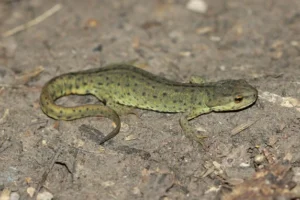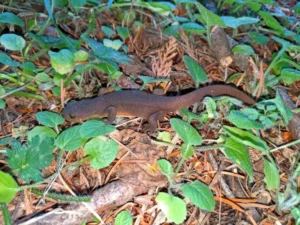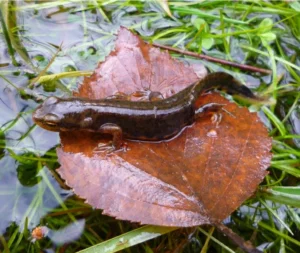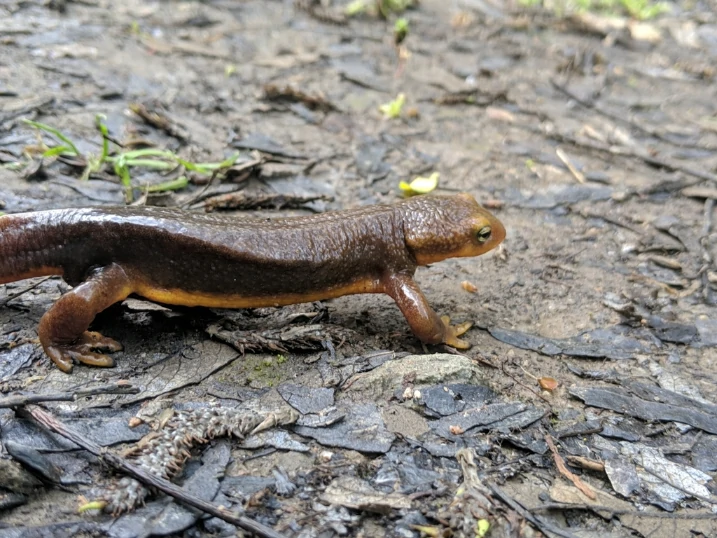Have you ever wondered why newts are sometimes hard to spot, even when you know they’re around?
It’s not that they’re hiding for no reason, they follow a natural rhythm that tells you when they are active.
When you get this rhythm, it’s easier to see them and watch these interesting creatures in action.
Newts are mostly crepuscular, which just means they’re most active at dawn and dusk. They also move at night, especially when it’s damp or raining. During the hottest or driest parts of the day, they usually hide under logs, leaves, or in water to stay safe and keep their skin from drying out.
Why Newts Like Dawn and Dusk
Newts are small and easy to hurt. Bright daylight brings heat and predators like birds or bigger animals. That’s why they wait for lower light to move safely.

At dawn, the air is cool, moisture is high, and insects such as crickets are buzzing around, making it the perfect time for hunting.
In the evening, birds and other predators slow down, giving newts another safe chance to move.
For example, if you walk near a pond at sunrise, you might see Eastern newts coming out of the water to hunt tiny insects or move across mossy ground.
At sunset, they might leave their hiding spots under logs to check the edges of a pond.
How Weather Changes When Newts Are Active
Weather really matters for newts. Rainy or humid days make them more active, even during the day.
Moisture keeps their skin from drying out and helps them breathe through their thin skin.
On hot, dry afternoons, newts usually stay hidden under leaves, logs, or plants in water.
If it suddenly rains, they may slide across the damp ground with surprising speed. Even a light drizzle can start a feeding or mating session.
Nighttime Activity: Why Newts Hunt at Night
Even though newts are mainly active at dawn and dusk, many move at night too. Darkness gives them cover from predators and keeps the air cooler and damp.
Nighttime is really important during breeding season.

Males might swim in ponds or along shallow streams, showing bright colors to attract females while staying safe from daytime dangers.
Young newts may explore nearby plants in the dark, learning to hunt insects without being seen.
If you watch them at night with a gentle flashlight or red light, you might see tiny efts or adults gliding quietly through shallow water, completely unseen during the day.
How Newts Change When They Are Active by Season
Seasons change everything for newts. In spring and early summer, when they’re breeding, newts are most active in the evenings.
Adults move between land and water, looking for mates or safe spots to lay eggs.
In late summer or fall, when it gets cooler, activity slows down, especially during the day.
Young efts may still explore damp evenings, but adults spend more time hiding to save energy.
In winter, many newts hibernate or burrow, cutting down activity sharply until spring starts again.
Watching Newts Safely During Their Active Hours
If you want to watch newts when they are most active, the best times are:
-
Dawn: Cool, quiet, with morning insects to eat.
-
Dusk: Predators retreat, and newts move freely along water edges.
-
Rainy or humid nights: Damp conditions encourage movement.
When you watch, move slowly and quietly.

Avoid stepping on plants, and don’t try to touch or catch them, they’re delicate, and handling can stress them or hurt their protective slime.
How When They Are Active Helps Them Survive
Newts’ timing is very important for survival. Moving mostly at dawn, dusk, or night helps them:
-
Avoid heat and drying out
-
Escape predators
-
Hunt insects, larvae, and worms
-
Find mates during breeding season
Even small changes in temperature or rain can shift their activity. A cool, cloudy day might get them moving mid-morning, while a hot, sunny day keeps them hidden until night.
Their rhythm is flexible but very purposeful.
Fun Facts About Newt Activity
-
Young orange efts are often more active in early morning, exploring damp forest floors.
-
Adult newts may travel between ponds and land in the evening.
-
Rain or high humidity can start bursts of activity in newts that usually stay hidden.
-
Predators affect timing: birds hunt during the day, so newts move when it’s safer and darker.
Watching a newt come out at dawn or slip quietly into water at dusk gives you a real sense of their hidden world and careful timing.
Conclusion
So, when are newts most active? Mostly at dawn, dusk, and on humid nights. Their schedule helps them stay safe, find food, and reproduce without drawing too much attention.
When you understand this rhythm, you can watch newts in their natural environment, see how smoothly they move, and learn how even small creatures use timing to survive.
Next time you see dew on leaves at sunrise or a quiet pond at twilight, look closely, you might catch a newt in action, perfectly following its hidden schedule.
Hi, my name is Ezra Mushala, i have been interested animals all my life. I am the main author and editor here at snakeinformer.com.

